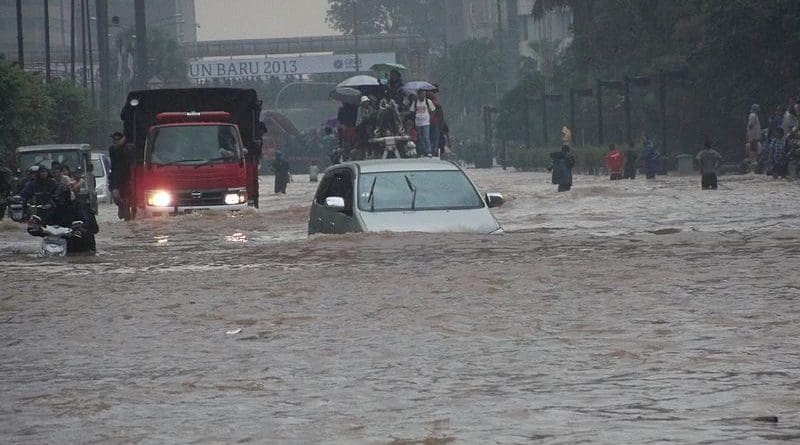Better Flood Management Can Save Jakarta – Analysis
By Emma Colven*
Flooding earlier this year in Jakarta, Southeast Asia’s largest city, provided a tragic reminder of the human costs of urban vulnerability. After embankments on the Citarum river broke, floodwaters reached up to 1.6 metres in some locations. Over 1700 people were evacuated by raft or waded to safety through dirty floodwaters, some carrying their small children. Five people lost their lives.
These floods were only the most recent in a series of increasingly frequent and devastating flood events in Jakarta (1996, 2002, 2007, 2013 and 2020). Flooding regularly brings the city to a standstill, taking lives and temporarily displacing hundreds, if not thousands, of residents. The General Insurance Association of Indonesia reported that the 2020 New Year’s Day flood cost insurers US$79 million in claims.
The provincial government of the Special Capital Region of Jakarta and the national ministries have long invested faith and money in a number of infrastructural interventions: sea walls, embankments, river straightening, flood gates and polder systems designed to control and channel unruly waters.
The dominance of this infrastructural approach to flood management today is partly a matter of path dependency, reflecting the enduring material and institutional legacies of the Dutch colonial period. Infrastructural interventions also gain political support because they provide both fast relief and visible evidence that the state is taking action. This makes them more ‘alluring’ than more mundane infrastructural investments, such as wastewater treatment or stormwater management.
Implementing hard infrastructure is also generally easier than tackling ‘soft’ infrastructure issues of governance, regulation and policy. This is especially true for Jakarta, where flood governance is highly complex and involves numerous state agencies at the local, provincial and national level.
But there are limits to an infrastructural approach to flood management as this year’s flooding attests. Jakarta’s previous governor, Basuki ‘Ahok’ Tjahaja Purnama, pursued a program of river normalisation — dredging, straightening and concretising Jakarta’s river. This project was popular with the middle class but ultimately did not prevent flooding.
River normalisation also involved forcibly removing residents living on riverbanks, and was deeply resented by those communities and their allies. In fact, flood management became a major driver of evictions: the Jakarta Legal Aid Institute reported that 48 of 113 evictions carried out in 2015 related to flood mitigation.
Some evicted households were resettled in rental apartments (rusunawa) that many found expensive, substandard or ill-suited to support the businesses residents once ran out of their homes. Others received no compensation at all. The harmful impacts of river normalisation on Jakarta’s most vulnerable communities demonstrates how adaptation projects have the capacity to make communities more vulnerable and impoverished.
Partly due to the increasingly contentious nature of river normalisation, Jakarta’s current governor Anies Baswedan has taken a more cautious approach to flood management than his predecessor. He removed river normalisation from the regional mid-term development plan, pursuing instead river naturalisation — a process that involves bringing a river back to its natural form. In contrast to Ahok’s heavy-handed and unapologetic approach to evictions, Baswedan has been reluctant to evict communities to procure the land needed for river naturalisation. While this is good news for residents in riverbank settlements, the slow implementation has earned Baswedan much criticism, especially as Jakarta continues to flood.
But ongoing discussions of normalisation and naturalisation distract us from the actual drivers of flooding, namely urban development and deep groundwater extraction. For too long, private developers have shaped the city’s development without consideration for the city’s residents and environment. Shopping malls, high-rise apartment buildings and luxury gated communities both upstream and downstream have consumed green space, mangroves and reservoirs, often in violation of spatial planning laws. This has contributed to worsening flooding.
Another major and related problem is deep groundwater extraction by apartment buildings, malls, hotels and industry. This has led to extremely high rates of land subsidence. The city is now sinking at rates that vastly outpace sea level rise, garnering Jakarta unwanted international attention. This is to some extent a problem of regulation and enforcement.
Many businesses and wealthy homeowners have a piped water connection but opt to use groundwater; other buildings fail to accurately report the number of wells they use. A solution to this problem exists. Tokyo was once sinking faster than Jakarta. By implementing several measures to reduce and offset groundwater extraction, the city government stopped the sinking.
While infrastructural interventions will remain necessary into the future, they offer only partial and ultimately temporary relief. If Jakarta is to survive in the context of a ‘new normal’, the government must more effectively regulate private sector development and halt deep groundwater exploitation by those who can access and afford to use other sources. Ultimately, this means addressing the question of who urban development benefits, and who it endangers.
*About the author: Emma Colven is Assistant Professor of Global Environment at the University of Oklahoma.
Source: This article was published by East Asia Forum

